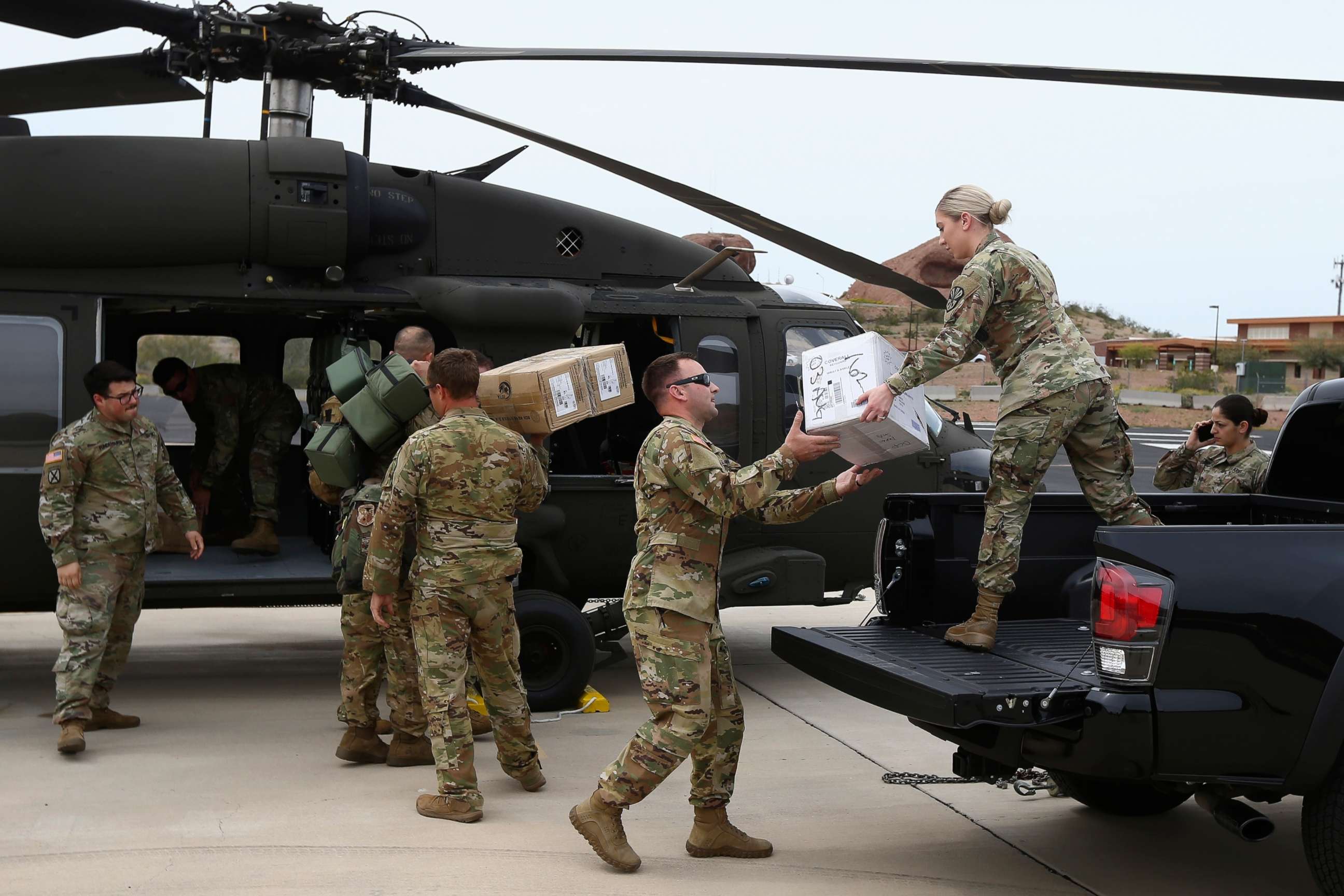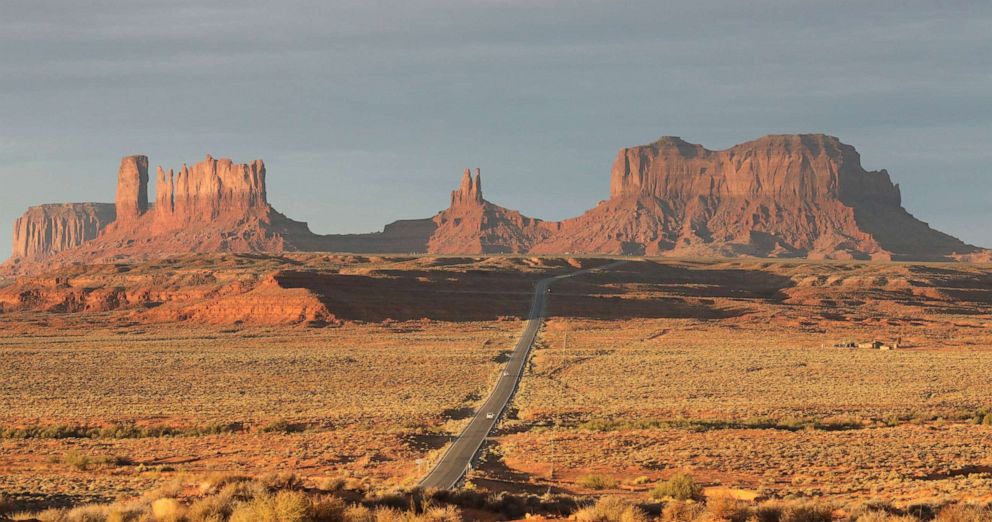Indian Country faces higher risks, lack of resources in COVID-19 fight
Experts worry about the pandemic's impact on Native American communities.
As the death toll from coronavirus rises in Navajo nation, experts closest to the crisis are tragically finding themselves the least surprised.
More and more conversations have circled back to warnings laid out nearly a decade ago, when the Centers for Disease Control and Prevention looked into the reasons the H1N1 flu killed four times the number of Native Americans compared to the rest of the population.
The 2009 study, commissioned by 12 states, found that the astronomically high death rate among Native Americans from H1N1 was largely because of health disparities like diabetes, heart disease and asthma that were — and still very much are — prevalent in Native American communities.
Laura Hammitt, director of Infectious Disease Programs for the Johns Hopkins Center for American Indian Health, has followed those trends back to 1918, when the Spanish flu nearly demolished Native American communities.
"If you think about the 1918 flu or the 2009 H1N1 influenza, during those respiratory viral pandemics we saw that Native American children and adults had markedly higher rates of both death and disease — sometimes in some cases four to five times higher than the general U.S. population," Hammitt said.
Why? A combination of high-risk health conditions, Hammitt said, as well as the impacts of poverty and the challenges of social distancing posed by crowded living situations.
The stark reality, however, is that despite the 100 years separating the Spanish flu and H1N1 — and the decade between H1N1 and coronavirus — those risks are still just as prevalent for Native American and communities across the country facing similar challenges.
Hammitt said the Navajo Nation and Indian Health Service are doing a great job responding to the crisis with the resources they have but there is still concern knowing how much of the population is high risk.
"I think what is happening on Navajo Nation is not unlike what will happen in other communities that are really significantly impacted by poverty," Hammitt told ABC.
Stacy Bohlen, the head of the National Indian Health Board, put it plainly. "We know that we have that vulnerability because of our health disparities," she told ABC News.

Despite the risk, health centers shutter when Indian Country needs them most
While the additional risks facing Native Americans are well-documented, tribes still say their requests for federal help to deal with the coronavirus are being ignored — resulting in the same shortages of personal protective equipment and health care staff as hospitals around the country.
Meredith Raimondi, a spokesperson for the National Council of Urban Indian Health Centers, said she knows of two clinics that have closed because they didn’t have enough staff and protective equipment to stay open.
She said the biggest concern across the board is a lack of supplies for hospitals and medical centers and that with the shortage of resources across the country tribes have seen little to no help.
"It really seems like Indian Country is going to continue to be last on the list and it's really concerning at this point," she told ABC News.
Urban Indian Health Centers are part of the Indian Health Service, a network that provides basic health care to tribal members at no cost. They exist as part of the federal government’s promise and legal obligation to provide health care to tribes, based on the constitution, treaties, and orders going as far back as 1787.
Raimondi said the centers have built up trust to provide "culturally competent" care in Native American communities where there is a lot of mistrust of the federal government.
"There's grave concern from our programs that there will be a lack of community trust going forward because if more clinics are forced to close their doors and shut down and people are going to have to be referred elsewhere, that they won't come back," she said.
A virus keying in on Indian Country
Native Americans have three times the rate of diabetes as non-hispanic white people, and in some places that rate is even higher, according to Bohlen, the head of the National Indian Health Board. They also face higher rates of asthma and cardiovascular disease — and each of those conditions put people at high risk for severe illness from coronavirus, according to the CDC.
Tribes also face separate challenges in following the basic guidelines set out by the CDC to protect against coronavirus — social distancing and washing your hands constantly.
For example, it’s common for as many as 12-15 people to live in a four-person house on a reservation, from grandparents to babies.
"It makes it very difficult to achieve social distancing in a scenario like that, and that's cultural -- the caring for each other on a multi-generational basis," Bohlen said.
Plus, not all homes have running water — a problem particularly affecting tribes in Montana, Alaska and in Navajo Nation, Bohlen said.
"When the CDC is putting out guidance that you have to wash your hands, several times a day — you know that makes it very difficult to wash your hands several times a day when you don't even have running water," she said.
Hammitt said it’s important for tribes to be able to adapt CDC guidance to the language or culture of the community. Johns Hopkins has been working with the Indian Health Service to adapt public service announcements that can be shared by tribes.
Some also fear for large elderly populations, who are particularly high risk and in many tribes serve as the protectors of a lifestyle that has been slowly chipped away at.
"That's where the impact will be felt the most — the greatest risk to our elder population is the greatest risk to to losing our language and our traditions and culture," Dr. Gayle Diné Chacon, who held the role of chief medical director for Navajo nation for two years, told ABC News in a phone interview.

Native American communities across the country say they are feeling the impact of those challenges during the COVID19 emergency.
Oj Semans, a member of the Rosebud Sioux Tribe that lies along the South Dakota and Nebraska border, said coronavirus seemed like it was "keying in" on Indian Country.
Both Semans and his wife, who run a voting rights advocacy group called Four Directors, have type 2 diabetes and asthma, putting them in the high-risk category.
"I mean, if you're looking for a point to be nervous at where it could really go wrong, it's here, in Indian Country," Semans said.
"It's just upping the danger for our people by multiplying the risks we already have," he said.
Semans, who lives on the reservation, described housing projects built close to one another and multiple families living in most homes.
"The apartment complexes are basically wall-to-wall, where you don't have that real social distancing," Semans said. "We're not built with the thought of a pandemic happening."
The threat is clear. Where is the help?
As the death toll in Navajo nation reaches eight and confirmed cases there make up more than two-thirds of the total in Indian Country, Chacon said it feels like the window for prevention has closed.
She feels she’s gotten the message out to her family because of her career as a doctor, but she knows that not every family has access to resources like hers does, nevermind the daily, constant reminders of the risks or how to stay safe that she harps on in phone calls to her relatives.
"It is so difficult because we keep saying we’re at war with something we can’t see," Chacon said. "But we all have to do our best ... we all have skills, we all hopefully have something we're good at and it's amazing to me to see the people who are rallying -- artists, putting posters and making beautiful artwork on why you need to stay home and people getting their sewing machines and sewing face masks and and putting native designs on it. People doing what they can in order to fix a big giant gap."
The spread, which Chacon called "stunning," has led New Mexico Democratic Gov. Michelle Lujan Grisham to warn Trump that the Navajo nation is at risk of being wiped out.
But despite those warnings, Navajo President Jonathan Nez warned that the tribe is not getting the supplies they need.
"There’s frustration from leadership ― not just here on Navajo but all of Indian Country," Nez said in a town hall over Facebook on Wednesday. "We feel that the United States government once again has ignored or even left out the first residents, the first people, the first citizens of this country: Indigenous people."
Bohlen, of the National Indian Health Board, backed up Nez’s frustration.
"We have an opportunity here to get it right," she urged.
She described a telephone listening session on Tuesday with the CDC and around 700 tribal leaders to discuss how the tribes want to use the $125 million allocated to them from the CDC for coronavirus response.
The Indian Health Service says they have started distributing some money for tribes in coronavirus response and the CARES Act passed by Congress included more than $3.5 billion for response in Indian Country, including for the health service, resources for tribes, and the Board of Indian Affairs.
The Navajo Nation now has roadblocks set-up in the hardest-hit areas, where strict curfews are being enforced. Crews are delivering food, firewood and coal to homes, taking care not to interact directly with occupants as they make deliveries. Medical facilities, like many around the country, are struggling to maintain supplies of protective equipment.
But the Navajo Nation and other tribes say they haven’t seen any money from multiple packages passed to aid COVID19 response in recent weeks, even though states have already received funding.
One issue that came up over and over again was personal protective equipment. Even as equipment and ventilators are sent across the nation from the federal stockpile to hot spots like New York, Louisiana and Michigan, states are under no obligation to dole it out to tribes. That must come from the federal government, which is under a "trust and treaty" obligation to tribes to provide health care.
"I don't know how much more we can beat that drum, I mean, we need the personal protective equipment," Bohlen said.
"I did not hear one tribal representative say [on the call with the CDC], 'thank you for the personal protective equipment, we have it’," she said. "But I heard repeatedly that they need it."




